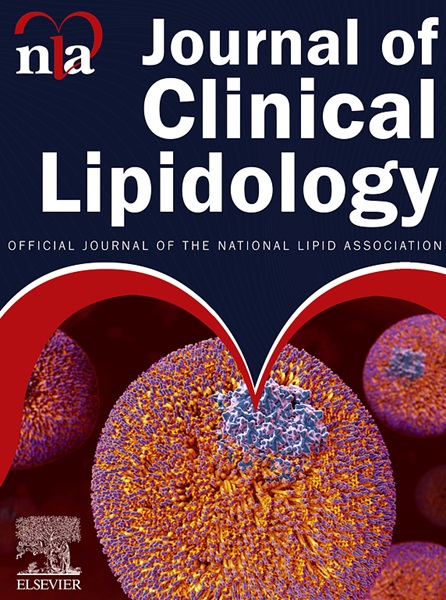利用医疗保健索赔数据来确定家族性高胆固醇血症患者的健康差异。
IF 4.6
3区 医学
Q2 PHARMACOLOGY & PHARMACY
引用次数: 0
摘要
背景:强化降脂治疗对于家族性高胆固醇血症(FH)患者达到目标低密度脂蛋白胆固醇(LDL-C)水平至关重要。然而,关于美国FH患者治疗使用差异的数据有限。方法:对覆盖3.24亿人的美国医疗索赔数据库(2016-2020)进行流行病学分析。本研究的纳入标准包括诊断为FH的个体,ICD-10诊断代码为E.78.01。采用基于多元logistic回归模型的g计算方法来估计人口统计学和社会经济变量对高强度他汀类药物、依折替米贝和蛋白转化酶枯草杆菌素/克辛蛋白9型抑制剂(PCSK9i)处方的边际效应。结果:在FH队列中(n = 85,457), 45.9%为女性,79.4%为白人,12.2%为黑人,8.4%为西班牙裔。男性比女性更有可能被开高强度他汀类药物:风险差异(RD) [95% CI] = 0.091 [0.086, 0.096];优势比(OR) [95% CI] = 2.03[1.95, 2.11]。与黑人相比,白人更有可能接受依折麦比、PCSK9i或联合治疗(RDs: 0.006-0.041;口服补液盐:1.22 - -1.32)。收入越高,接受这些治疗的几率越高(收入在5万美元以下的患者,相对差值为0.005-0.060,相对差值为1.17-1.58)。高等教育与接受这些治疗的可能性更高有关(一些大学及以上教育水平的相对比值比:0.004-0.038,or: 1.06-1.49)。结论:这些发现突出了显著的差异,对白人、高收入和受教育程度较高的人开了更密集的降脂治疗。这强调了为所有FH患者制定公平的心血管风险降低策略的必要性。本文章由计算机程序翻译,如有差异,请以英文原文为准。
Using healthcare claims data to identify health disparities for individuals with familial hypercholesterolemia
BACKGROUND
Intensive lipid-lowering therapy is crucial for individuals with familial hypercholesterolemia (FH) to reach target low-density lipoprotein cholesterol (LDL-C) levels. However, there are limited data on disparities in therapy use among FH patients in the US.
METHODS
An epidemiologic analysis of a US healthcare claims database (2016-2020) covering 324 million individuals. Inclusion criteria for this study comprised of individuals with a diagnosis of FH, defined by an ICD-10 diagnosis code of E.78.01. The G-computation approach based on multiple logistic regression models was used to estimate the marginal effects of demographic and socioeconomic variables on prescriptions for high-intensity statins, ezetimibe, and proprotein convertase subtilisin/kexin type 9 inhibitors (PCSK9i).
RESULTS
In the FH cohort (n = 85,457), 45.9% were female, 79.4% identified as White, 12.2% as Black, and 8.4% as Hispanic. Males were more likely to be prescribed high-intensity statins than females: risk difference (RD) [95% CI] = 0.091 [0.086, 0.096]; odds ratio (OR) [95% CI] = 2.03 [1.95, 2.11]. White individuals were more likely to get ezetimibe, PCSK9i, or combination therapy compared to Black individuals (RDs: 0.006-0.041; ORs: 1.22-1.32). Higher income was associated with increased odds of receiving these treatments (RDs: 0.005-0.060 and ORs: 1.17-1.58 for incomes >$50,000). Higher education was linked to a higher likelihood of receiving these treatments (RDs: 0.004-0.038 and ORs: 1.06-1.49 for education levels of some college and higher).
CONCLUSION
These findings highlight significant disparities, with more intensive lipid-lowering therapies prescribed to White, higher-income, and better-educated individuals. This underscores the need for equitable cardiovascular risk reduction strategies for all FH patients.
求助全文
通过发布文献求助,成功后即可免费获取论文全文。
去求助
来源期刊
CiteScore
7.00
自引率
6.80%
发文量
209
审稿时长
49 days
期刊介绍:
Because the scope of clinical lipidology is broad, the topics addressed by the Journal are equally diverse. Typical articles explore lipidology as it is practiced in the treatment setting, recent developments in pharmacological research, reports of treatment and trials, case studies, the impact of lifestyle modification, and similar academic material of interest to the practitioner.
Sections of Journal of clinical lipidology will address pioneering studies and the clinicians who conduct them, case studies, ethical standards and conduct, professional guidance such as ATP and NCEP, editorial commentary, letters from readers, National Lipid Association (NLA) news and upcoming event information, as well as abstracts from the NLA annual scientific sessions and the scientific forums held by its chapters, when appropriate.

 求助内容:
求助内容: 应助结果提醒方式:
应助结果提醒方式:


